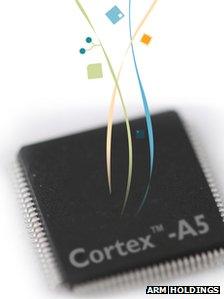AMD and ARM team up to improve PC security with Trustzone
- Published

The team-up offers PC software developers additional security features
Advanced Micro Devices (AMD) is to license technology from rival chip designer ARM Holdings.
The US firm plans to add an ARM-based processor to its computer chipsets alongside its own x86-based CPU (central processing unit) and GPU (graphics processing unit) technology.
The ARM-based core will be dedicated to offering security features to safeguard actions such as online payments.
Analysts say this could be the beginning of an important relationship.
Both firms compete against the world's largest semiconductor chip maker, Intel.
Safer computing
AMD made the announcement at its Fusion Developer Summit in Seattle.
The firm said it intended to incorporate an ARM Cortex-A5 CPU to its chips for what it terms "superthin" laptops from 2013, across chips for other mainstream computers in 2014, and beyond that into servers.
The move is designed to offer PC software developers access to ARM's Trustzone technology.
The security feature only lets approved software run on the extra core, making it harder for hackers and malware to disrupt processes.
Potential uses include enhanced authentication systems for mobile banking, anti-virus software that is itself safe from attack, and digital rights management software which can better prevent media files from being pirated.
"It runs the code in a very isolated environment that is well protected from the bigger x86 environment," AMD's chief information officer, Mike Wolfe, told the BBC.
"Security is all a complexity argument. What you want to do is reduce the amount of code that a security function depends on because every 1,000 lines of code or so has a bug in it. Clearly when you are running hundreds of millions of lines of code the probability of having a bug is pretty high.
"So by reducing that environment and restricting the functions to well-defined properties you are reducing a lot of that risk."
ARM's reach
ARM already offers use of Trustzone to developers writing apps for tablets and smartphones that use its chip architecture, but this marks a move into a new market.

AMD will pay ARM a fee for each A5 processor built into its chipset
"We clearly see a trend of broader deployment of similar content and applications on multiple screens, and extending this into the x86 environment solves, what we believe, is an industry problem," said Tom Lantzsch, ARM's executive vice president of corporate development.
The announcement was deemed highly significant by Sergis Mushell, principal research analyst at the tech consultancy Gartner.
"Think about the number of smartphones and tablet devices out there," he said.
"If their apps are going to use a certain methodology to do transactions, then having the same security technology built into PCs makes sense.
"For AMD this is about leveraging what is out there rather than trying to invent every part of the wheel."
AMD was explicit that it also intended to incorporate the technology into chipsets designed for tablet computers - products where consumers put a premium on battery life. Mr Mushell suggested this could prove an opportunity for further co-operation.
"AMD might also decide to add additional ARM cores to their existing technologies to create a new kind of hybrid chipset," he added.
"But this absolutely should not be seen as AMD giving up on its own x86 architecture."
- Published31 May 2012
- Published15 May 2012
- Published26 April 2012